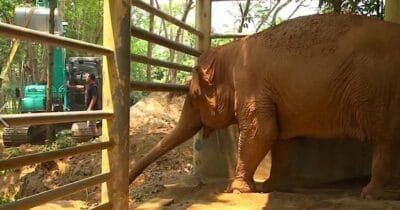
Today marked the end of an era in Washington D.C., as three pandas headed back to China, ending more than 50 years of pandas in the nation’s capital.
Three giant pandas who have been a fixture of Smithsonian’s National Zoo — parents Tian Tian, 26, Mei Xiang, 25, and their 3-year-old offspring Xiao Qi Ji — are en route back to China, 23 years after first arriving in Washington, as a lease agreement between China and the US is set to expire next month.

Mei Xiang and Tian Tian first arrived in 2000 and were supposed to stay for 10 years, but the agreement was extended several times, according to CBS News.
Pandas returning to China
According to a press release from the zoo, the pandas’ crates were lifted by forlift out of the David M. Rubenstein Family Giant Panda Habitat and loaded on to custom FedEx trucks. They then boarded a FedEx Panda Express Boeing 777F aircraft, and are now embarking on a 19-hour flight to Chengdu, China. They are traveling with plenty of food for their long flight, including 220 pounds of bamboo.
They will then be transported to their new home at the China Conservation and Research Center for the Giant Panda.
Mei Xiang and Tian Tian were the second pair of giant pandas to live at the National Zoo. Mei Xiang gave birth to four surviving cubs: Tai Shan, born 2005, Bao Bao, born 2013, and Bei Bei, born 2015, are all reportedly thriving in China.
When her youngest cub Xiao Qi Ji was born in 2020, it made headlines around the world: at 22 years old, Mei Xiang was the oldest giant panda to give birth in the US and the second-oldest in the world, defying the slim odds to give birth to her “miracle cub.”
“Because Mei Xiang is of advanced maternal age, we knew the chances of her having a cub were slim,” said zoo director Steve Monfort. “However, we wanted to give her one more opportunity to contribute to her species’ survival. I am incredibly proud of our animal care and science teams, whose expertise in giant panda behavior was critical to this conservation success.”
The pandas’ departure marks a bittersweet moment for zoo staff and fans: it is the first time in decades that the beloved, iconic animals won’t be a part of the National Zoo. In recent weeks, many visited the zoo to see the pandas one last time.
“It’s probably going to be a long time, possibly one of the last times I see a panda in captivity,” Ryan Nickol, who traveled from Pennsylvania to see the pandas multiple times in recent weeks, told NBC News. “It’s pretty frustrating and also a little sad.”

“I think in some ways, people identify the panda as theirs as much as or more than they think of it as something from China,” Elena Songster, history professor and author of the book Panda Nation, told NPR.
“Panda diplomacy”
Giant pandas are native only to China, but the country has gifted or leased pandas to countries around the world as part of a practice called “panda diplomacy.” For China, the pandas act as a symbol of diplomatic ties with other nations.
Pandas were first given to the United States in 1972, gifted from Mao Zedong to US President Richard Nixon as part of developing ties between the two nations. First Lady Pat Nixon donated the pandas to the National Zoo, where they became a sensation, attracting over a million visitors within the first year.

In 1984, China changed their policy, saying that countries would be leased instead of gifted to other countries. Beginning in 1991, China offered ten-year leases on pandas, in exchange for a $1 million fee per year, and under the condition that any cubs born during the lease would belong to China.
This international program has contributed to the successful conservation of pandas. In 2021, it was announced that the long-struggling species was no longer endangered, but downgraded to “vulnerable.”
“The two sides have formed good cooperative relations, achieved fruitful results and played a positive role in protecting endangered species,” spokesperson Mao Ning of China’s Ministry of Foreign Affairs said, according to CNN. “The purpose is to better protect endangered species and promote global biodiversity conservation.”

But after decades of partnership, China is allowing the US panda leases to expire, likely due to increased political tensions between the two nations. Zoo Atlanta is now the only US zoo with giant pandas, and with their own loan agreement set to expire next year, it is likely that the US will soon have no pandas for the first time since the Nixon era.
Other nations may soon be panda-less as well: according to NBC News, a pair of pandas at the Edinburgh Zoo, the only pandas in the UK, are set to return to China next year, while Australia is negotiating an extension of their loan agreement for two pandas at the Adelaide Zoo.
Hope for the future
While the future is uncertain, National Zoo staff are cautiously optimistic that pandas may one day return, calling their departure a “hiatus,” although China has not indicated whether the program might continue.
As the beloved pandas leave for China, the staff expressed pride in what they’ve accomplished over the past few decades and remain hopeful for the future.

“As Tian Tian, Mei Xiang and Xiao Qi Ji depart for their new home in China, they leave behind a tremendous legacy in Washington, D.C.,” Brandie Smith, a director at the zoo, said in the press release. “It is exciting and humbling that people around the world have followed these pandas, shared in our joys and rooted for our success. I am incredibly proud of our animal care experts and researchers, whose observations and research in giant panda biology, behavior, reproduction, health and native habitat have helped move giant pandas off the endangered species list.”
“As this chapter of our giant panda program closes, we remain committed to the conservation of this species and look forward to continued collaboration with our Chinese colleagues.”
It’s definitely the end of an era, and we know that many people in the Washington DC area will miss the beloved pandas at the National Zoo. We wish this panda family the best as they return to China.
Please share this news.






